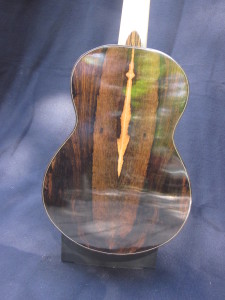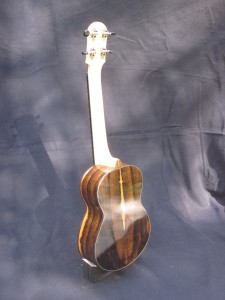This uke is another example of what can be done with multi-layer laminated sides and back. Here the black locust sides and back are overlayed with ziricote. This has an Alaskan yellow cedar neck, richlite fingerboard, ebony bridge, bocote headstock overlay, and my Jupiter logo in multiple colors of mother of pearl.
I have started using Alaskan yellow cedar for necks because it is stiff and light. I think that the lightness in weight gives a better balance to the instrument (holding/playing wise) than a heavier neck wood like cherry or walnut.
The fingerboard is richlite, which is a synthetic material that a number of commercial guitar makers have started to use. It is perfectly stable, hard, will not crack, dry out, or otherwise mis-behave like a piece of wood might. In addition, it provides a nice black surface while not impacting the world’s dwindling supply of black ebony.
This uke has a bracing system I have been moving towards, which has fewer but ‘taller’ braces. The stiffness of a brace, which is just like a beam, is proportional to the width of the beam, and the square of the height. So by making the bracing thinner yet taller I can make the brace lighter but just as stiff. Lighter means that the string energy has less wood it needs to move around, meaning that more energy can go into moving the top as a whole, which means more volume. This uke is quite loud, across the scale, from the highs to the lows.
In case you want to make some more noise, this uke also has a K&K TwinSpot piezo pickup installed, so you can plug it it. The electronics add to the cost of the instrument, but I charge only what the parts cost me. I take no mark-up on the parts themselves.






